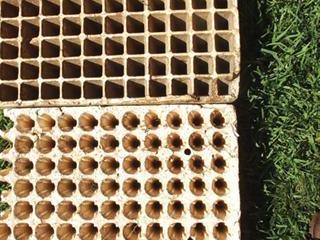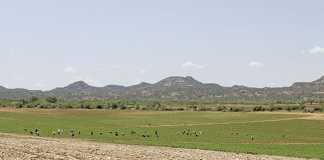
The larger the volume of medium in the seedling plug, the bigger the seedling will become before there is an imbalance between medium volume and plant volume. The fewer the seedlings in a seedling tray, the more expensive they are to produce and the crop will, to a large extent, determine what size is best.
A 300-cell tray, for example, means you will pay less per seedling. But because there’s less medium in each cavity, and because the seedlings are so close together and competing more for light, you will have to transplant them at a smaller size or suffer planting setback with the associated hazards.
Also, the medium composition and fertilisation should be such that the plug is full of roots when the top growth is the right size for pulling. Crops such as lettuce and celery aren’t too affected by being in 300-cell trays, but if a planter is used, it must be able to cope with ‘shorter’ plants. If you are hand-planting, be careful that the plants are not covered.
The most common tray is the 200-cell model, as it’s a middle-of-the-road compromise providing standardisation for commercial seedling growers. Growers who produce their own seedlings, however, may find it more practical to use different trays for different crops. There is a definite advantage to go to a larger plug for tomatoes. The extra light individual plants receive, combined with the wider spacing, encourages the plant to flower earlier and produce larger flower trusses.
Sun energy
To understand why, let’s go back thousands of years to when wild tomatoes had to compete with many other species in order to survive. If a plant used too much sun energy to produce fruit as a young seedling in competition with other plants, vegetative growth would be compromised and it could lose the battle against weeds, die and be unable to reproduce its genes.
On the other hand, a plant which used the sun’s energy to advance vegetative growth would likely make it through the canopy to get all the sunlight it needed to set a good crop and advance its genes with these traits going to the next generation. I had a client who used to transplant his 200-cell tomato seedlings into small plastic bags so that these plants were much larger when transplanted.
When he transplanted these next to plants that came straight from the trays, you could see the higher yield in the lower section of the plants from the bag seedlings. A compromise here is to use 128-cell seedling trays. There are other advantages when planting in spring in cold areas and having to wait for frosty weather to pass. A larger seedling means faster early development and an earlier, higher yield from the first picking.
Soil volume
Seedling development in the nursery also becomes more advanced when there’s more soil in the cavity. In other words, 200-cell trays with square plugs will hold more medium than those with round plugs. The difference is easily seen when seedlings from both are planted alongside each other – despite the fact each group receives the same amount of sunlight.
The disadvantage with square cells is that the weakest point between the cavities is longer, therefore the tray could break more easily. As these trays take a little more medium, your inputs will also be slightly higher. Aside from hardness, seedlings which have a greater volume of medium in the cells can be allowed to become proportionately larger before ‘transplant shock’. They can also be transplanted as softer, actively growing seedlings with less chances of problems.
More attention
To sum up, seedlings are an extremely important, but widely neglected, stage of a crop. A good start is vital for growth. There’s also a psychological factor, here. If the crop starts off well, the farmer gives it more attention, while crops that have a bad start tend to be neglected. This I have not only experienced myself, but have also seen on many farms.
Contact Bill Kerr on 016 366 0616 or at [email protected]. Please state ‘Vegetable production’ in the subject line of your email.











